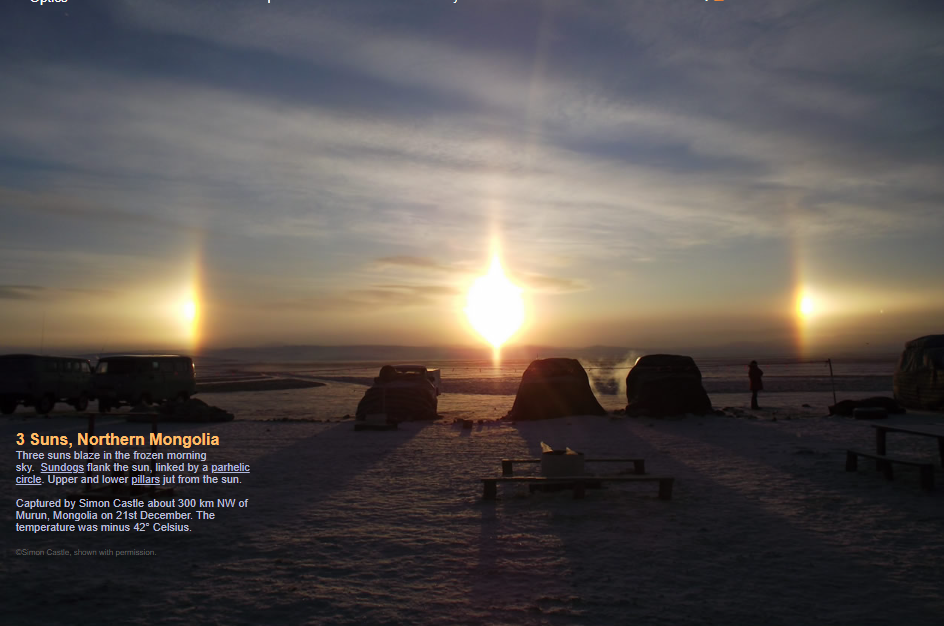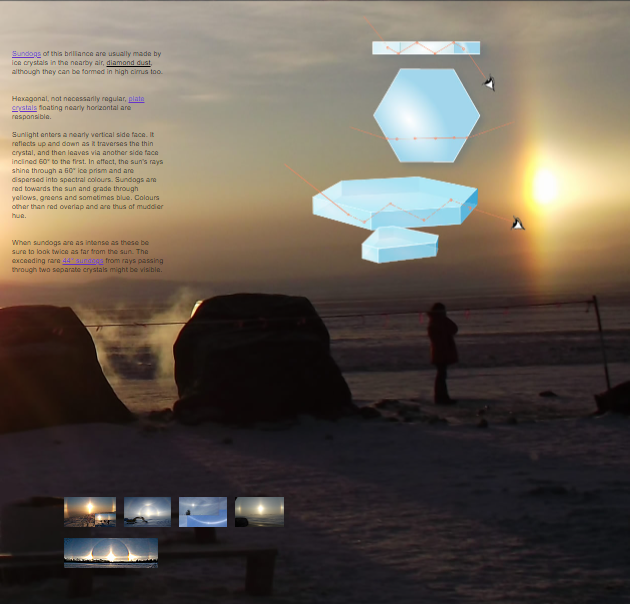OPOD - Three Suns - Mongolia
OPOD - Three Suns - Mongolia: A Breathtaking Atmospheric Phenomenon
Have you ever witnessed a truly awe-inspiring atmospheric phenomenon? Picture this: a frozen morning sky in Northern Mongolia, where three suns blaze brightly, casting an ethereal glow over the landscape. This captivating sight was captured by photographer Simon Castle, about 300 km NW of Murun, Mongolia, on December 21st. The temperature at the time was a bone-chilling minus 42° Celsius. In this article, we will delve into the mesmerizing spectacle of three suns in the sky and unravel the science behind this extraordinary occurrence.
Sundogs and Parhelic Circles
The main protagonists in this celestial performance are the sundogs and the parhelic circle. Sundogs, also known as mock suns or parhelia, are luminous spots that appear on either side of the sun. They are typically formed by ice crystals suspended in the air, often referred to as diamond dust. These hexagonal plate crystals, which float nearly horizontally, play a crucial role in creating the stunning display of three suns in Mongolia's frigid skies.
The Ice Prism Effect
To understand how sundogs are formed, we must delve into the intricate workings of ice crystals and sunlight. When sunlight enters a nearly vertical side face of a hexagonal ice crystal, it undergoes a series of reflections and refractions within the crystal. The light then exits through another side face that is inclined at an angle of approximately 60° to the first face. This process effectively transforms the hexagonal ice crystal into a 60° ice prism.
A Kaleidoscope of Colors
As sunlight passes through the ice prism, it is dispersed into its spectral colors, creating a mesmerizing array of hues. Sundogs appear red towards the sun and gradually transition through yellows, greens, and sometimes blues. The overlapping of colors, other than red, results in muddier hues. The intensity of the sundogs captured in Castle's photograph is truly remarkable, with vibrant and well-defined colors that captivate the eye.
Rare 44° Sundogs
While sundogs are a relatively common occurrence, those with an intensity as striking as the ones observed in Mongolia are quite rare. In certain cases, when rays of sunlight pass through two separate ice crystals, an exceedingly rare phenomenon known as 44° sundogs may occur. These sundogs are located twice as far from the sun as the regular ones and offer a truly remarkable spectacle for those fortunate enough to witness them.
Exploring the Optics of the Skies
The study of atmospheric optics allows us to unravel the mysteries behind such captivating phenomena. By understanding the interaction between sunlight and various atmospheric particles, we can appreciate the breathtaking displays that nature unveils before our eyes. From the shimmering beauty of sundogs to the intricate patterns of parhelic circles, these optical wonders remind us of the vast complexity and beauty of our natural world.
Beyond Mongolia: Global Phenomena
While the three suns observed in Mongolia are undoubtedly a stunning sight, similar atmospheric phenomena can be witnessed in various parts of the world. From the Arctic regions to high-altitude cirrus clouds, the interplay between sunlight and ice crystals can create a multitude of mesmerizing displays. Whether it's the iridescent colors of a circumzenithal arc or the ethereal glow of a glory, exploring atmospheric optics opens up a world of wonder and beauty.
In conclusion, the sight of three suns blazing in the sky above Northern Mongolia is a testament to the awe-inspiring wonders that our atmosphere can offer. Through the interplay of ice crystals and sunlight, sundogs create a kaleidoscope of colors that captivate our senses and ignite our curiosity. While such occurrences may be rare, they remind us of the boundless beauty and complexity that surround us. So, the next time you find yourself gazing at the sky, remember to look beyond the ordinary and embrace the extraordinary spectacle of atmospheric optics.

3 Suns, Northern Mongolia
Three suns blaze in the frozen morning sky. Sundogs flank the sun, linked by a parhelic circle. Upper and lower pillars jut from the sun.
Captured by Simon Castle about 300 km NW of Murun, Mongolia on 21st December. The temperature was minus 42° Celsius.
©Simon Castle, shown with permission.

Sundogs of this brilliance are usually made by ice crystals in the nearby air, diamond dust, although they can be formed in high cirrus too.
Hexagonal, not necessarily regular, plate crystals floating nearly horizontal are responsible.
Sunlight enters a nearly vertical side face. It reflects up and down as it traverses the thin crystal, and then leaves via another side face inclined 60° to the first. In effect, the sun's rays shine through a 60° ice prism and are dispersed into spectral colours. Sundogs are red towards the sun and grade through yellows, greens and sometimes blue. Colours other than red overlap and are thus of muddier hue.
When sundogs are as intense as these be sure to look twice as far from the sun. The exceeding rare 44° sundogs from rays passing through two separate crystals might be visible.
Note: this article has been automatically converted from the old site and may not appear as intended. You can find the original article here.
Reference Atmospheric Optics
If you use any of the definitions, information, or data presented on Atmospheric Optics, please copy the link or reference below to properly credit us as the reference source. Thank you!
-
<a href="https://atoptics.co.uk/blog/opod-three-suns-mongolia/">OPOD - Three Suns - Mongolia</a>
-
"OPOD - Three Suns - Mongolia". Atmospheric Optics. Accessed on November 25, 2024. https://atoptics.co.uk/blog/opod-three-suns-mongolia/.
-
"OPOD - Three Suns - Mongolia". Atmospheric Optics, https://atoptics.co.uk/blog/opod-three-suns-mongolia/. Accessed 25 November, 2024
-
OPOD - Three Suns - Mongolia. Atmospheric Optics. Retrieved from https://atoptics.co.uk/blog/opod-three-suns-mongolia/.